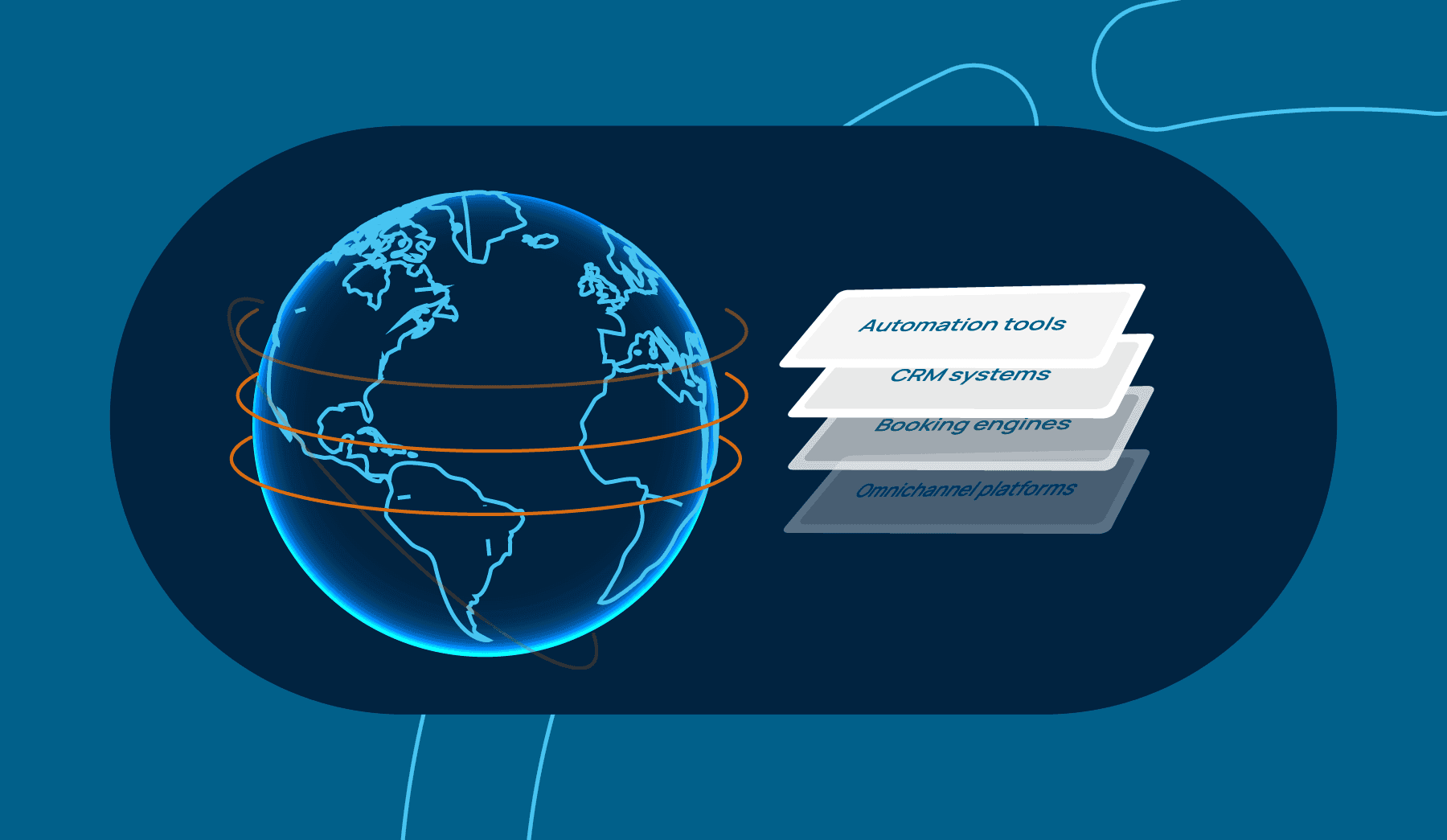How Airline Distribution Works: Guide for Travel Agency Leaders

Airlines are regaining control of how their inventory gets distributed, and it is important for travel agencies to understand how airline distribution works. Ranga Prasad, CEO at Iween, says, “Decoding how flight inventory is sourced, priced, and sold directly impacts travel agencies’ margin strategy, the customer experience they weave, and their competitive positioning.” Airline distribution is way past accessing fares through a GDS and issuing a PNR. Today, airlines are no longer just selling seats; they’re retailing experiences—from preferred seating and baggage to bundled packages tailored to travelers. And to support this shift, airlines are pushing for direct, API-driven sales channels (eg, NDC), bypassing traditional systems (eg, GDS) that agencies have relied on for decades.
Now, CEOs and travel agency owners need to rethink commission structures, supplier relationships, and value-added services, while CTOs are tasked with integrating new distribution technologies and automating workflows that bridge legacy GDS models with modern API-based retailing. It starts with knowing where that content originates, how it's priced, and why airlines are shifting their sales strategies. Ranga adds, “By understanding how airline distribution works—its players, workflows, and emerging models—you gain the insight to optimize your travel tech stack for hybrid inventory i.e., GDS + NDC + direct, capture new revenue streams through ancillaries and dynamic offers, negotiate better deals with suppliers and consolidators, and future-proof your travel agency in an industry racing towards airline-controlled retailing.”
Yet, for many agency owners and even tech leaders, airline distribution still remains a black box filled with acronyms—GDS, NDC, BSP, etcetera.
Read this guide as we break down the complex airline distribution ecosystem into clear, actionable insights designed specifically for you and other decision-makers at your travel agency.
Key Players in the Airline Distribution Ecosystem
Airline distribution involves stakeholders beyond airlines and travel agents—it’s a complex network of interconnected players, each with its own incentives, technologies, and business models. To make informed strategic and technical decisions, as a travel agency leader, you must understand the following key players of the ecosystem.
a) Airlines
Airlines are the primary owners of flight inventory and control pricing strategies across their networks. Their core focus is on maximizing revenue per seat using sophisticated yield management systems, selling ancillaries such as baggage and seat upgrades, and increasingly shifting towards direct retailing.
In recent years, airlines have been moving to bypass traditional intermediaries by adopting New Distribution Capability (NDC) APIs, allowing them to deliver personalized offers and exclusive bundles through their own sales channels or to agencies integrated with NDC. This trend is reshaping how travel agencies access and compete for airline content.
b) GDS (Global Distribution Systems)
Global Distribution Systems, such as Amadeus, Sabre, and Travelport, have historically served as the backbone of airline distribution for travel agencies. They aggregate inventory from multiple airlines and provide travel businesses with the technology needed for searching flights, booking, ticketing, and settlement.
The appeal of GDSs lies in their standardized workflows and integration with the Billing and Settlement Plan (BSP), which simplifies back-office processes.
However, reliance on GDS is declining as airlines adopt NDC and begin offering differentiated content outside traditional GDS channels, forcing travel agencies to rethink how they source inventory and serve customers.
c) OTAs (Online Travel Agencies)
Online Travel Agencies, such as Expedia, Booking.com, and MakeMyTrip, have transformed consumer expectations with their digital-first approach.
OTAs make it easy for travelers to compare fares and book flights online without interacting with traditional agencies. Their scale enables them to negotiate deep discounts with airlines and fund aggressive marketing campaigns, often setting public price benchmarks that traditional agencies struggle to match.
For agency owners, OTAs represent both competition and a lesson in the importance of leveraging technology to deliver convenience and transparency to customers.
d) Consolidators & Wholesalers
Consolidators play a crucial role, especially in international travel markets.
They purchase airline seats in bulk—often at significant discounts—and resell them to agencies at net fares that are lower than published prices. This gives agencies access to competitive pricing for niche markets such as ethnic routes or complex itineraries.
Over time, many consolidators have evolved into tech-driven aggregators, offering API integrations and white-label booking platforms that make their inventory easier to access and distribute. This shift benefits agencies by combining the advantages of consolidator pricing with modern distribution technology.
e) IATA & Industry Bodies
The International Air Transport Association (IATA) governs much of the global airline distribution framework. It regulates ticketing standards, manages settlement systems like BSP, and introduces key industry initiatives such as NDC and ONE Order to streamline retailing and post-booking processes.
In the United States, the Airline Reporting Corporation (ARC) performs a similar role.
These organizations ensure industry interoperability but also set the pace for regulatory and technological changes that agencies must adopt to remain compliant and competitive.
f) Metasearch Engines
Metasearch engines like Google Flights, Skyscanner, and Kayak have become influential in shaping consumer behavior. These platforms aggregate flight data from multiple sources—airlines, OTAs, and sometimes agencies—allowing travelers to compare prices quickly before being redirected to the supplier’s site for booking.
While metasearch engines are not direct booking platforms, they significantly influence purchase decisions and often bypass agencies entirely, making it harder for traditional players to capture direct customer engagement.
How the Traditional Airline Distribution Works (Legacy Model)
For years, airline distribution has functioned on a legacy model that was based on templated, rigid processes and centralized systems. It has been good, but not enough anymore. Thus, it is being increasingly disrupted by newer, API-based retailing models like NDC. Agency leaders need to have an understanding of the legacy airline distribution in order to understand where it fell short and why the new methods are becoming popular.
a) Fare Filing and ATPCO
Under the conventional model, airlines share their fares for the inventory with the Airline Tariff Publishing Company (ATPCO). Fares, along with related rules and conditions (such as refundability, advance purchase limitations), are forwarded to Global Distribution Systems (GDS). ATPCO guarantees that all travel agents linked through GDSs view the same published fares and can sell them uniformly. This system is static, though—fares are filed on a regular basis and are not conducive to real-time dynamic pricing or personalized offers.
b) GDS Connectivity and PSS (Passenger Service Systems)
Airlines link their Passenger Service Systems (PSS) to GDS platforms. The PSS helps manage inventory, schedules, reservations, and ticketing. When an agency searches for a flight through the GDS, it retrieves availability and fare data from the airline's PSS. This interface has traditionally been standardized and universal, enabling agencies to access hundreds of airlines through one interface.
c) Airline Booking Flow (Legacy)
The agent retrieves flights in the GDS by entering pre-defined commands or using point-and-click tools. The GDS requests flight choices from airline systems and furnishes them to agents. The fares are tiered according to ATPCO fare rules in the GDS. When a ticket is booked, the GDS produces an electronic ticket (e-ticket), stores it in the airline's PSS, and updates the Billing and Settlement Plan (BSP) for financial settlement.
This simplified procedure was groundbreaking during its era, but its inflexibility makes it less relevant in today's AI-driven travel booking ecosystem.
d) Commission and Incentive Structures
Traditionally, airlines compensated agencies with handsome commissions for ticket sales through GDSs. Over a period, commissions shrank, and agency revenue models were limited to service fees paid by clients or GDS platform incentives against volume-based sales. This also builds a GDS lock-in for the agencies.
Drawbacks of the Legacy Model
Although the legacy model facilitated worldwide standardization and scalability, it has obvious limitations in the form of
- Static prices (fares are pre-filed and have no dynamic real-time tweaking)
- Constrained ancillaries (add-ons such as baggage or preferred seating are cumbersome to sell in GDS flows
- Indirect airline ownership (airlines need to pay GDS commissions and have partial control over offers)
- Restrained innovation (new retail ideas, such as bundling and personalization, are tough to achieve via GDS channels)
These limitations have driven the rise of New Distribution Capability (NDC) and API-based distribution models, which we’ll explore next.
NDC (New Distribution Capability): The Way Modern Airlines Distribute Content
The legacy GDS-driven model has long been criticized for its rigidity and inability to adapt to modern retailing needs. To overcome this, the International Air Transport Association (IATA) launched the New Distribution Capability (NDC), a revolutionary XML-based data standard that transforms the way airlines distribute their products. It is important for travel agency stakeholders to understand how NDC content is disrupting the Airline booking space and the efficiency, scale, and cost-cutting possibilities it unlocks—
- For CEOs and owners of travel agencies, NDC signifies access to differentiated content and the opportunity to enhance airline relationships, yet it also encompasses operational adjustments and expenditures.
- For CTOs, it requires streamlining supplier API integrations at scale, as now every airline might have its own NDC API. Besides, CTOs also need to navigate the road to building a reliable, high-performing, and secure technical stack without upsetting the CFO.
Many small travel agencies do not have a dedicated CTO, and thus, the onus of minimising the cost of procuring inventory, distributing the same is the responsibility of the CEO and tech head (if they have one). As a leader of such an agency, you need to understand if NDC can be your answer to more affordable content sourcing, increasing your margins, and adding diversification to your inventory. Accordingly, you need to plan for your travel tech stack.
a) What is NDC?
NDC is an IATA-supported initiative enabling airlines to deliver their content directly to agencies and partners via API-based connections, without the limitations of traditional GDS. It differs from fare filing through ATPCO in that NDC enables airlines to push dynamic offers with real-time prices, personalized packages, and ancillary products such as baggage fees, seat selection fees, and lounge visits. Essentially, NDC reimagines airline distribution from static fare lists to retail-driven e-commerce.
b) Why Airlines Are Driving NDC
This transition to NDC is essentially bringing airline sales closer to a direct retail model, weaning them off intermediaries. Airlines have powerful incentives to embrace NDC aggressively:
- Lower distribution costs for the airlines as they cut overheads by dodging GDS fees
- More control over customer experience since airlines can manage directly how fares and ancillaries are bundled and priced
- They can dynamically provide rich content (images, videos, branded fare names) and keep the users engaged with fresh content
NDC APIs enable airlines to surf the personalisation wave and personalize offers according to traveller profiles, loyalty status, or market demand.
c) How NDC Alters The Usual Agency Workflow
For travel agencies, NDC is both an opportunity and a disruption. Opportunity as NDS helps you reimagine your booking flows and user experience with ancillaries, bundles, and dynamic prices presented differently than GDS fare. But it also disrupts the legacy workflows. Rather than using a single GDS interface, now you need to access more than one NDC API from various airlines. So, integrating 100 flights to your platform might require you to dabble with 100 APIs. That’s no easy task.
Managing 100s of NDC APIs could give engineering & business teams migraine, esp when the APIs keep changing. However, you don’t need to panic. There is a way around, i.e., API aggregators. These aggregators pre-integrate APIs and help you quickly add new supplier APIs to your booking platform. For example, Iween gives you access to 160+ supplier APIs through 1 single API—API Gateway.
Also, the Mid-back-office systems (ticketing, invoicing, and BSP reconciliation) that exist within travel agencies must be flexible enough to support non-GDS workflows. Agencies that don't transform risk losing out on NDC-only fares and content that airlines do not want to serve via GDSes.
d) NDC Challenge for Travel Agencies
NDC adoption, however promising, has been slow and patchy because of fragmentation.
- The NDC implementation of each airline can be different, thus requiring individual integrations
- And it calls for agencies' up-front travel technology investment, and hence requires enhanced online booking tools and mid-office systems to enable NDC
- In addition, a high learning curve can be an obstacle for the personnel. Frontline personnel have to learn new workflows and selling methods.
- Furthermore, agencies have to handle both GDS and NDC channels at once during the transition process.
The NDC Impact on Airline Retailing
One of the most significant changes in the industry is the transition from static fare distribution to real-time airline retailing. As shared earlier, airlines no longer are simply selling seats—they're acting like e-commerce merchants, utilizing technology to generate dynamic, customized offers optimized for revenue and customer experience.
a) Fare Filing to Retailing
In the past, airfares were pre-filed via ATPCO and presented consistently on GDSs and agencies. Nowadays, with NDC and direct APIs, carriers can sidestep this inflexible framework and construct real-time offers immediately dependent on market, traveler, and booking context.
For instance, rather than presenting all passengers with the same fare, airlines can now dynamically set prices, package ancillaries (e.g., bag + priority boarding), or offer limited-time promotions—all in real-time. This brings distribution closer to how leading e-commerce sites like Amazon operate, where offers are presented in real-time to achieve conversions.
b) Ancillary Revenue as a Growth Engine
Ancillaries—add-on services to the core fare—have become a significant source of revenue for airlines. They encompass:
- Seat selection (exit row, preferred, extra legroom)
- Checked and carry-on bags
- Priority boarding and lounge passes
- Onboard services (meal, Wi-Fi, upgrade)
For travel agencies, ancillary retailing via NDC is essential. Travel agencies that adopt ancillary retailing can grow revenue, enhance customer satisfaction by providing tailored bundles, and take a portion of the $118+ billion global ancillary revenue opportunity.
c) Personalization and Dynamic Pricing
- Personalization is what motivates modern airline retailing. Airlines can now leverage traveler profiles—frequent flyer status, prior travel history, or even search history—to offer customized propositions. For example, a business traveler may view a premium economy upgrade paired with lounge privileges, and a low-cost flyer may view basic economy prices with add-ons that are paid for.
- Dynamic pricing is also central, leveraging AI and revenue management tools to reprice fares in real time, taking into account demand, competition, and even how searches fall within the day. This results in no two customers seeing the same price or package; however, there is also cohort-led personalization.
Implications of GDS, NDC, and Direct Connect Airline Distribution for Travel Agencies & Tech Leaders
The transformation from traditional fare distribution to airline retailing driven by API is transforming the way agencies do business. For executives, it's not merely a technology change—it's a business model change, revenue model change, and competitive landscape change.
For Agency Owners and CEOs: Strategic Implications
- Margin Compression Calls for Value-Added Services
Commissionable airline tickets have all but disappeared, and incentive-based GDS models are being squeezed. Agencies will need to shift towards service-based revenue, imposing consultation fees, bundling ancillaries, or providing premium assistance to warrant value added above ticketing.
- Supplier Relationships Are More Important Than Ever
Airlines are embracing direct distribution (NDC), at times holding back their best fares from GDSs. Establishing close airline relationships or tapping into consolidator networks can help obtain exclusive inventory and improved commercial terms.
- Market Segmentation Is the Key
Generalist agencies will struggle. Specializing in corporate travel, luxury leisure, or niche routes enables agencies to leverage expertise that cannot be easily duplicated by OTAs or airline-direct channels.
- Hybrid Distribution Models Will Rule
In the near term, agencies will balance GDS content, NDC APIs, and consolidator feeds. Leaders will need to make investments in workflows and staffing models that can cope with the complexity without increasing the cost of operation.
For CTOs and Tech Decision-Makers: Operational Consequences
- Integration Becomes the Central Challenge
Multiple sources of content must be supported by tech stacks: GDS, direct airline APIs (NDC), consolidators, and even metasearch. Middleware or aggregator platforms can mitigate integration overhead but introduce third-party vendor dependency.
- Mid-Back-Office Systems Need to Adapt
Legacy reporting, ticketing, and accounting systems were designed for GDS workflows. With NDC, CTOs require solutions that manage mixed ticketing, BSP and non-BSP sales reconciliation, and automated ancillary integration into invoicing.
- Automation and AI for Efficiency
While content becomes fragmented, automation will be key—auto-pricing, agentic AI ticketing, and auto-reconciliations can minimize manual effort while accelerating speed to market.
- Scalable API Infrastructure
NDC and airline APIs create more transactional volume than GDS queries. CTOs need to ensure that their booking engines, caching layers, and infrastructure are capable of better handling increased API volumes.
The Iween Perspective
Agencies adopting airline retailing will be able to distinguish themselves in a competitive market by providing customers with end-to-end travel products consisting of dynamic fare, ancillaries, and value-added services. They will be better able to provide a consumer-centric experience with high-quality images and transparent, retail-oriented shopping similar to OTAs and airline websites.
It takes tight alignment between business strategy and technology implementation to succeed in today's airline distribution. CEOs are responsible for specifying the revenue and supplier strategy, but CTOs have to make sure the tech stack is aligned with it, either by embracing NDC aggregators, improving in-house booking sites, or using analytics to discover the most valuable distribution mix.
The bottom line is that retailing for airlines is all about transforming from inventory access to value creation. Agencies that function as authentic retail partners—providing dynamic propositions—can capture loyalty in an industry that's moving in an increasingly airline-dominated direction.

Nishant Choudhary
Content MarketerIn this article
1.Key Players in the Airline Distribution Ecosystem
2.How the Traditional Airline Distribution Works (Legacy Model)
3.Drawbacks of the Legacy Model
4.NDC (New Distribution Capability): The Way Modern Airlines Distribute Content
5.The NDC Impact on Airline Retailing
6.Implications of GDS, NDC, and Direct Connect Airline Distribution for Travel Agencies & Tech Leaders
7.The Iween Perspective



